Conceptual Framework for Corporate Reporting
VerifiedAdded on 2023/04/03
|17
|3848
|347
AI Summary
This report discusses the importance of the conceptual framework in corporate reporting and its role in financial reporting. It covers the history and development of the CF and its application in the USA, UK, and Australia. The report also explores the advantages and disadvantages of the CF, the major components of financial statements prepared as per the CF, and the recognition principles and measurement bases used. Additionally, it discusses the concept of integrated reporting and compares GRI and IR.
Contribute Materials
Your contribution can guide someone’s learning journey. Share your
documents today.
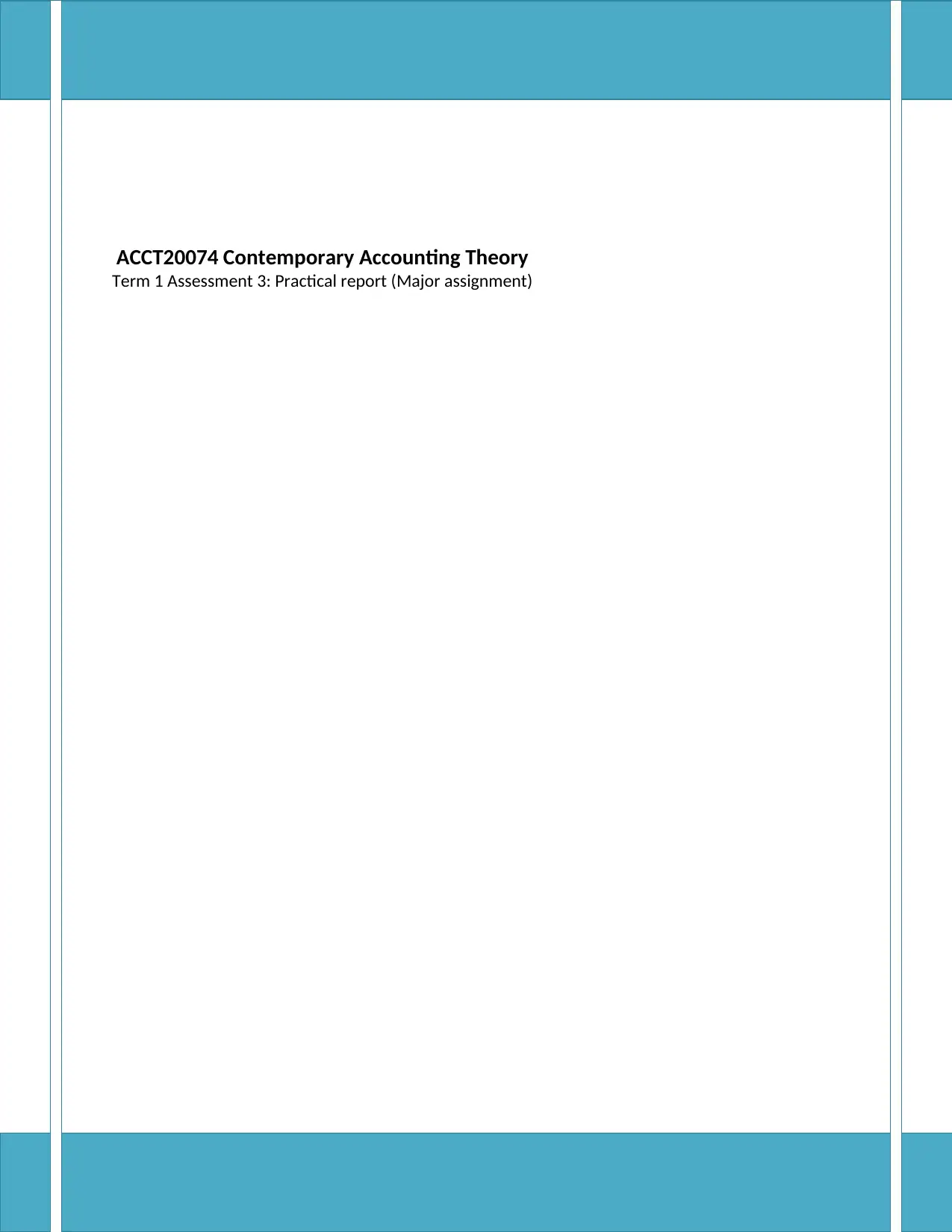
ACCT20074 Contemporary Accounting Theory
Term 1 Assessment 3: Practical report (Major assignment)
Term 1 Assessment 3: Practical report (Major assignment)
Secure Best Marks with AI Grader
Need help grading? Try our AI Grader for instant feedback on your assignments.
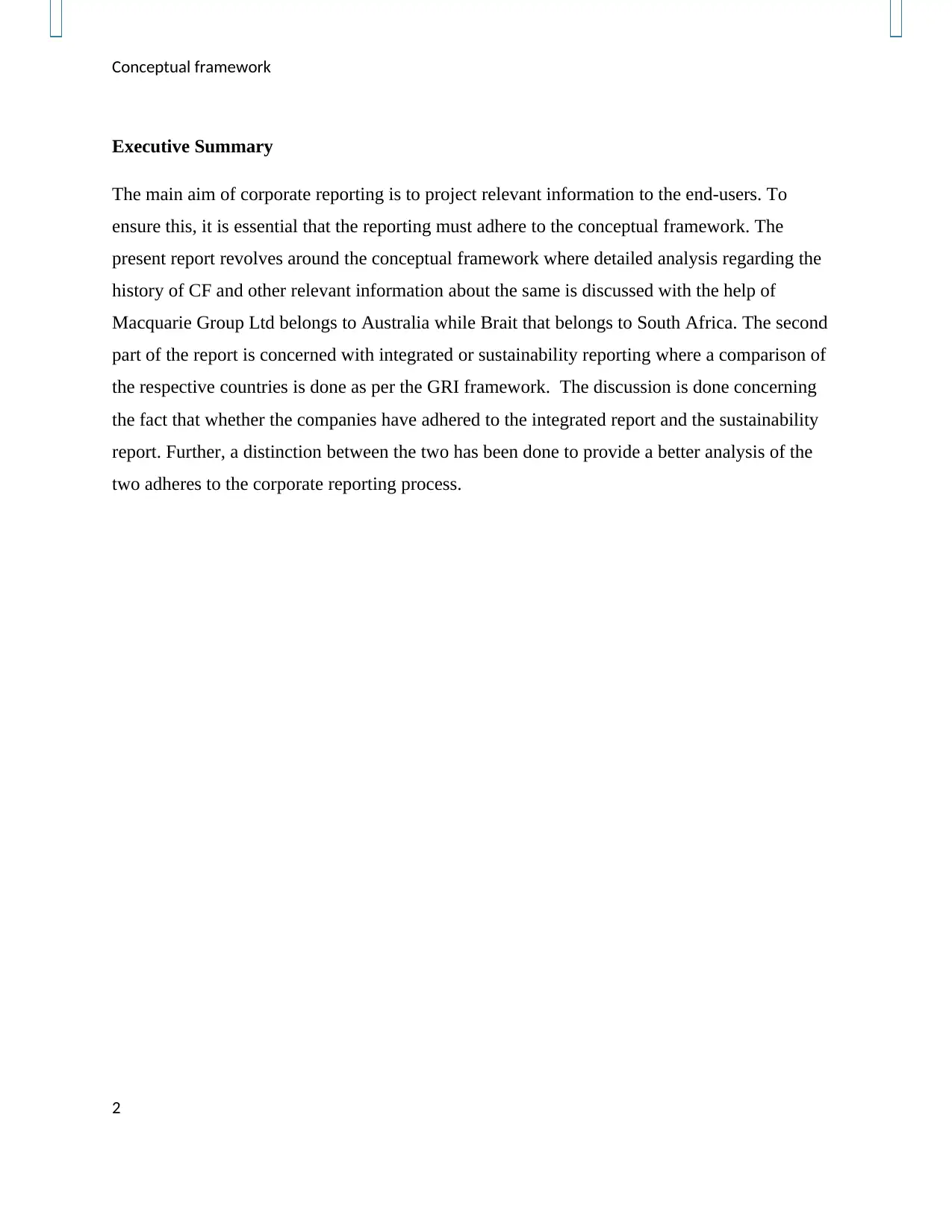
Conceptual framework
Executive Summary
The main aim of corporate reporting is to project relevant information to the end-users. To
ensure this, it is essential that the reporting must adhere to the conceptual framework. The
present report revolves around the conceptual framework where detailed analysis regarding the
history of CF and other relevant information about the same is discussed with the help of
Macquarie Group Ltd belongs to Australia while Brait that belongs to South Africa. The second
part of the report is concerned with integrated or sustainability reporting where a comparison of
the respective countries is done as per the GRI framework. The discussion is done concerning
the fact that whether the companies have adhered to the integrated report and the sustainability
report. Further, a distinction between the two has been done to provide a better analysis of the
two adheres to the corporate reporting process.
2
Executive Summary
The main aim of corporate reporting is to project relevant information to the end-users. To
ensure this, it is essential that the reporting must adhere to the conceptual framework. The
present report revolves around the conceptual framework where detailed analysis regarding the
history of CF and other relevant information about the same is discussed with the help of
Macquarie Group Ltd belongs to Australia while Brait that belongs to South Africa. The second
part of the report is concerned with integrated or sustainability reporting where a comparison of
the respective countries is done as per the GRI framework. The discussion is done concerning
the fact that whether the companies have adhered to the integrated report and the sustainability
report. Further, a distinction between the two has been done to provide a better analysis of the
two adheres to the corporate reporting process.
2
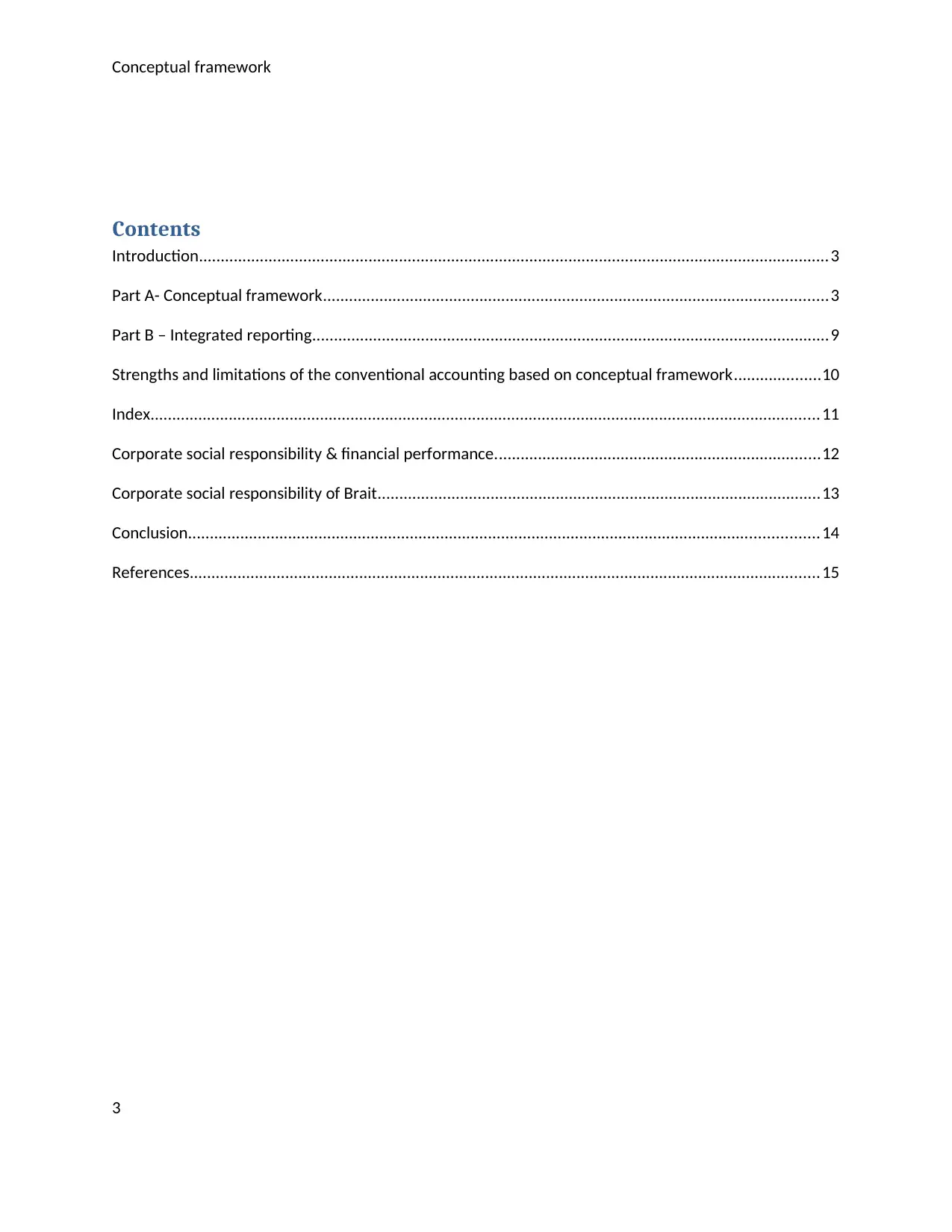
Conceptual framework
Contents
Introduction.................................................................................................................................................3
Part A- Conceptual framework....................................................................................................................3
Part B – Integrated reporting.......................................................................................................................9
Strengths and limitations of the conventional accounting based on conceptual framework....................10
Index..........................................................................................................................................................11
Corporate social responsibility & financial performance...........................................................................12
Corporate social responsibility of Brait......................................................................................................13
Conclusion.................................................................................................................................................14
References.................................................................................................................................................15
3
Contents
Introduction.................................................................................................................................................3
Part A- Conceptual framework....................................................................................................................3
Part B – Integrated reporting.......................................................................................................................9
Strengths and limitations of the conventional accounting based on conceptual framework....................10
Index..........................................................................................................................................................11
Corporate social responsibility & financial performance...........................................................................12
Corporate social responsibility of Brait......................................................................................................13
Conclusion.................................................................................................................................................14
References.................................................................................................................................................15
3
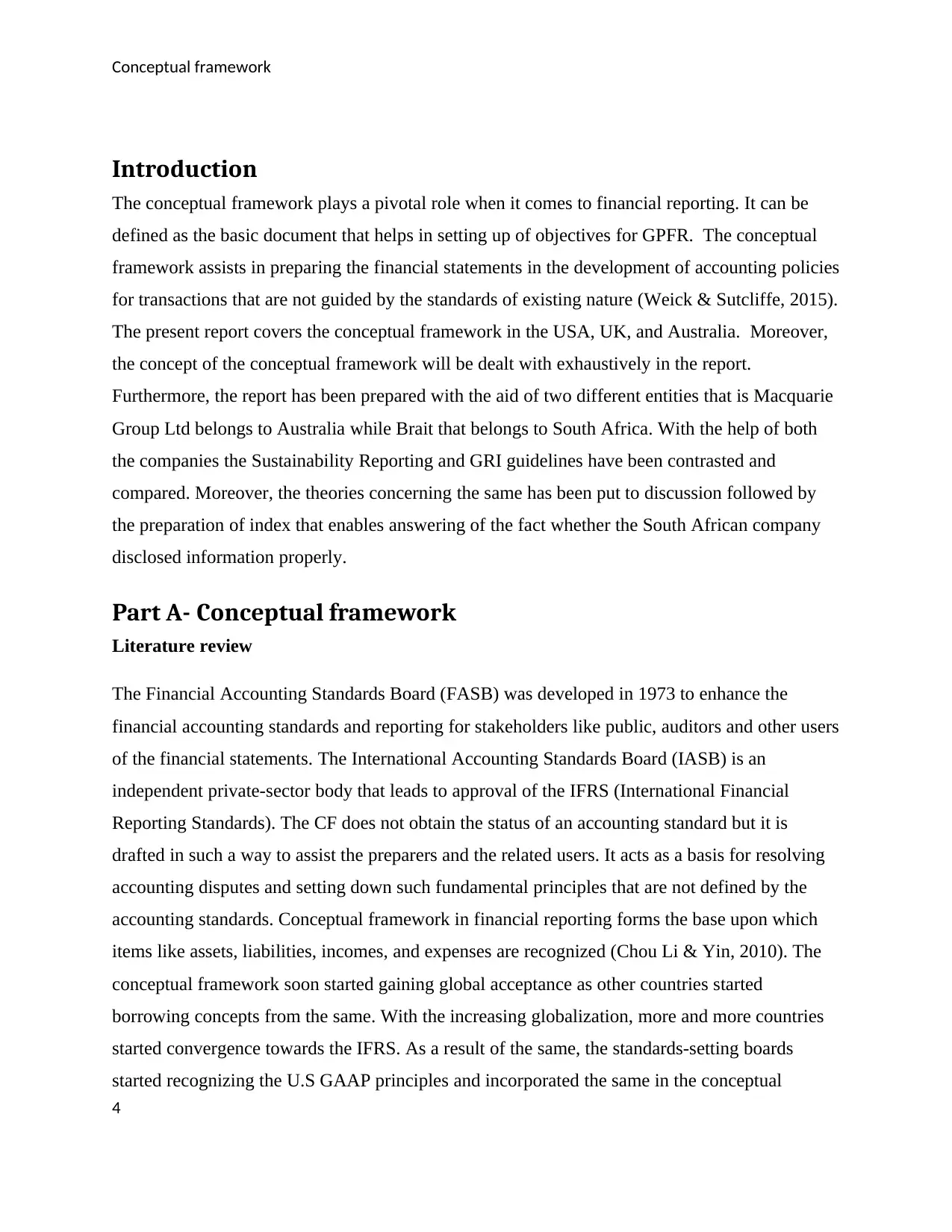
Conceptual framework
Introduction
The conceptual framework plays a pivotal role when it comes to financial reporting. It can be
defined as the basic document that helps in setting up of objectives for GPFR. The conceptual
framework assists in preparing the financial statements in the development of accounting policies
for transactions that are not guided by the standards of existing nature (Weick & Sutcliffe, 2015).
The present report covers the conceptual framework in the USA, UK, and Australia. Moreover,
the concept of the conceptual framework will be dealt with exhaustively in the report.
Furthermore, the report has been prepared with the aid of two different entities that is Macquarie
Group Ltd belongs to Australia while Brait that belongs to South Africa. With the help of both
the companies the Sustainability Reporting and GRI guidelines have been contrasted and
compared. Moreover, the theories concerning the same has been put to discussion followed by
the preparation of index that enables answering of the fact whether the South African company
disclosed information properly.
Part A- Conceptual framework
Literature review
The Financial Accounting Standards Board (FASB) was developed in 1973 to enhance the
financial accounting standards and reporting for stakeholders like public, auditors and other users
of the financial statements. The International Accounting Standards Board (IASB) is an
independent private-sector body that leads to approval of the IFRS (International Financial
Reporting Standards). The CF does not obtain the status of an accounting standard but it is
drafted in such a way to assist the preparers and the related users. It acts as a basis for resolving
accounting disputes and setting down such fundamental principles that are not defined by the
accounting standards. Conceptual framework in financial reporting forms the base upon which
items like assets, liabilities, incomes, and expenses are recognized (Chou Li & Yin, 2010). The
conceptual framework soon started gaining global acceptance as other countries started
borrowing concepts from the same. With the increasing globalization, more and more countries
started convergence towards the IFRS. As a result of the same, the standards-setting boards
started recognizing the U.S GAAP principles and incorporated the same in the conceptual
4
Introduction
The conceptual framework plays a pivotal role when it comes to financial reporting. It can be
defined as the basic document that helps in setting up of objectives for GPFR. The conceptual
framework assists in preparing the financial statements in the development of accounting policies
for transactions that are not guided by the standards of existing nature (Weick & Sutcliffe, 2015).
The present report covers the conceptual framework in the USA, UK, and Australia. Moreover,
the concept of the conceptual framework will be dealt with exhaustively in the report.
Furthermore, the report has been prepared with the aid of two different entities that is Macquarie
Group Ltd belongs to Australia while Brait that belongs to South Africa. With the help of both
the companies the Sustainability Reporting and GRI guidelines have been contrasted and
compared. Moreover, the theories concerning the same has been put to discussion followed by
the preparation of index that enables answering of the fact whether the South African company
disclosed information properly.
Part A- Conceptual framework
Literature review
The Financial Accounting Standards Board (FASB) was developed in 1973 to enhance the
financial accounting standards and reporting for stakeholders like public, auditors and other users
of the financial statements. The International Accounting Standards Board (IASB) is an
independent private-sector body that leads to approval of the IFRS (International Financial
Reporting Standards). The CF does not obtain the status of an accounting standard but it is
drafted in such a way to assist the preparers and the related users. It acts as a basis for resolving
accounting disputes and setting down such fundamental principles that are not defined by the
accounting standards. Conceptual framework in financial reporting forms the base upon which
items like assets, liabilities, incomes, and expenses are recognized (Chou Li & Yin, 2010). The
conceptual framework soon started gaining global acceptance as other countries started
borrowing concepts from the same. With the increasing globalization, more and more countries
started convergence towards the IFRS. As a result of the same, the standards-setting boards
started recognizing the U.S GAAP principles and incorporated the same in the conceptual
4
Secure Best Marks with AI Grader
Need help grading? Try our AI Grader for instant feedback on your assignments.
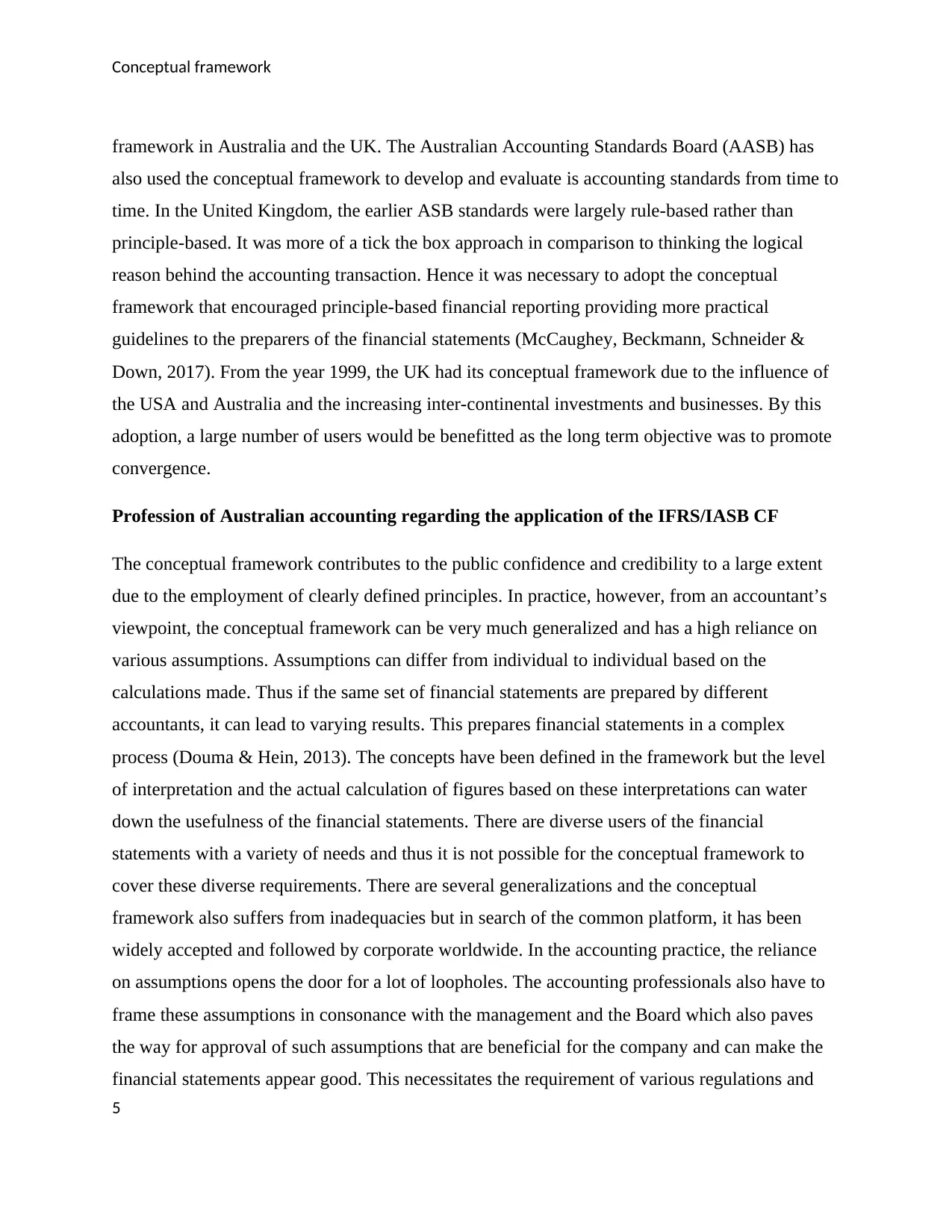
Conceptual framework
framework in Australia and the UK. The Australian Accounting Standards Board (AASB) has
also used the conceptual framework to develop and evaluate is accounting standards from time to
time. In the United Kingdom, the earlier ASB standards were largely rule-based rather than
principle-based. It was more of a tick the box approach in comparison to thinking the logical
reason behind the accounting transaction. Hence it was necessary to adopt the conceptual
framework that encouraged principle-based financial reporting providing more practical
guidelines to the preparers of the financial statements (McCaughey, Beckmann, Schneider &
Down, 2017). From the year 1999, the UK had its conceptual framework due to the influence of
the USA and Australia and the increasing inter-continental investments and businesses. By this
adoption, a large number of users would be benefitted as the long term objective was to promote
convergence.
Profession of Australian accounting regarding the application of the IFRS/IASB CF
The conceptual framework contributes to the public confidence and credibility to a large extent
due to the employment of clearly defined principles. In practice, however, from an accountant’s
viewpoint, the conceptual framework can be very much generalized and has a high reliance on
various assumptions. Assumptions can differ from individual to individual based on the
calculations made. Thus if the same set of financial statements are prepared by different
accountants, it can lead to varying results. This prepares financial statements in a complex
process (Douma & Hein, 2013). The concepts have been defined in the framework but the level
of interpretation and the actual calculation of figures based on these interpretations can water
down the usefulness of the financial statements. There are diverse users of the financial
statements with a variety of needs and thus it is not possible for the conceptual framework to
cover these diverse requirements. There are several generalizations and the conceptual
framework also suffers from inadequacies but in search of the common platform, it has been
widely accepted and followed by corporate worldwide. In the accounting practice, the reliance
on assumptions opens the door for a lot of loopholes. The accounting professionals also have to
frame these assumptions in consonance with the management and the Board which also paves
the way for approval of such assumptions that are beneficial for the company and can make the
financial statements appear good. This necessitates the requirement of various regulations and
5
framework in Australia and the UK. The Australian Accounting Standards Board (AASB) has
also used the conceptual framework to develop and evaluate is accounting standards from time to
time. In the United Kingdom, the earlier ASB standards were largely rule-based rather than
principle-based. It was more of a tick the box approach in comparison to thinking the logical
reason behind the accounting transaction. Hence it was necessary to adopt the conceptual
framework that encouraged principle-based financial reporting providing more practical
guidelines to the preparers of the financial statements (McCaughey, Beckmann, Schneider &
Down, 2017). From the year 1999, the UK had its conceptual framework due to the influence of
the USA and Australia and the increasing inter-continental investments and businesses. By this
adoption, a large number of users would be benefitted as the long term objective was to promote
convergence.
Profession of Australian accounting regarding the application of the IFRS/IASB CF
The conceptual framework contributes to the public confidence and credibility to a large extent
due to the employment of clearly defined principles. In practice, however, from an accountant’s
viewpoint, the conceptual framework can be very much generalized and has a high reliance on
various assumptions. Assumptions can differ from individual to individual based on the
calculations made. Thus if the same set of financial statements are prepared by different
accountants, it can lead to varying results. This prepares financial statements in a complex
process (Douma & Hein, 2013). The concepts have been defined in the framework but the level
of interpretation and the actual calculation of figures based on these interpretations can water
down the usefulness of the financial statements. There are diverse users of the financial
statements with a variety of needs and thus it is not possible for the conceptual framework to
cover these diverse requirements. There are several generalizations and the conceptual
framework also suffers from inadequacies but in search of the common platform, it has been
widely accepted and followed by corporate worldwide. In the accounting practice, the reliance
on assumptions opens the door for a lot of loopholes. The accounting professionals also have to
frame these assumptions in consonance with the management and the Board which also paves
the way for approval of such assumptions that are beneficial for the company and can make the
financial statements appear good. This necessitates the requirement of various regulations and
5
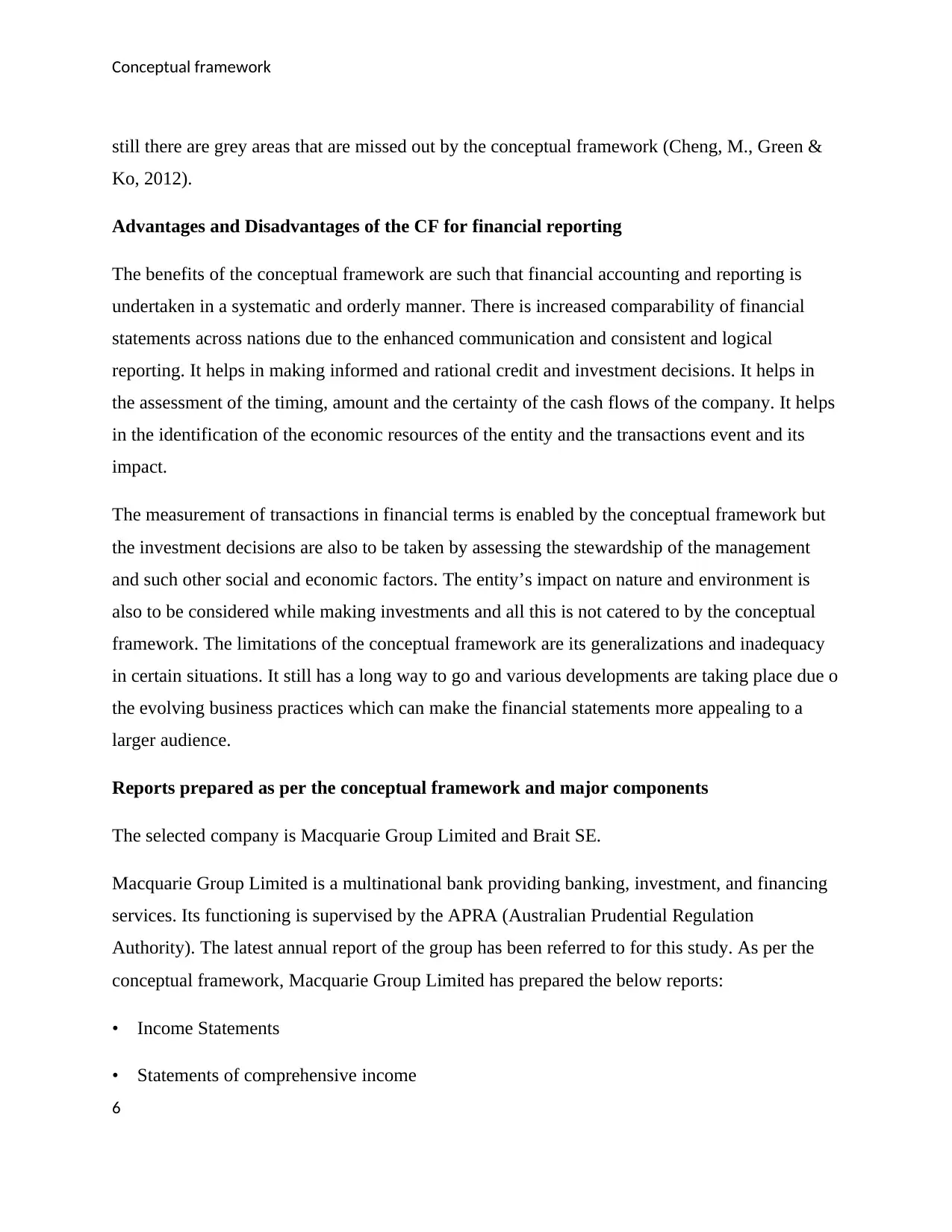
Conceptual framework
still there are grey areas that are missed out by the conceptual framework (Cheng, M., Green &
Ko, 2012).
Advantages and Disadvantages of the CF for financial reporting
The benefits of the conceptual framework are such that financial accounting and reporting is
undertaken in a systematic and orderly manner. There is increased comparability of financial
statements across nations due to the enhanced communication and consistent and logical
reporting. It helps in making informed and rational credit and investment decisions. It helps in
the assessment of the timing, amount and the certainty of the cash flows of the company. It helps
in the identification of the economic resources of the entity and the transactions event and its
impact.
The measurement of transactions in financial terms is enabled by the conceptual framework but
the investment decisions are also to be taken by assessing the stewardship of the management
and such other social and economic factors. The entity’s impact on nature and environment is
also to be considered while making investments and all this is not catered to by the conceptual
framework. The limitations of the conceptual framework are its generalizations and inadequacy
in certain situations. It still has a long way to go and various developments are taking place due o
the evolving business practices which can make the financial statements more appealing to a
larger audience.
Reports prepared as per the conceptual framework and major components
The selected company is Macquarie Group Limited and Brait SE.
Macquarie Group Limited is a multinational bank providing banking, investment, and financing
services. Its functioning is supervised by the APRA (Australian Prudential Regulation
Authority). The latest annual report of the group has been referred to for this study. As per the
conceptual framework, Macquarie Group Limited has prepared the below reports:
• Income Statements
• Statements of comprehensive income
6
still there are grey areas that are missed out by the conceptual framework (Cheng, M., Green &
Ko, 2012).
Advantages and Disadvantages of the CF for financial reporting
The benefits of the conceptual framework are such that financial accounting and reporting is
undertaken in a systematic and orderly manner. There is increased comparability of financial
statements across nations due to the enhanced communication and consistent and logical
reporting. It helps in making informed and rational credit and investment decisions. It helps in
the assessment of the timing, amount and the certainty of the cash flows of the company. It helps
in the identification of the economic resources of the entity and the transactions event and its
impact.
The measurement of transactions in financial terms is enabled by the conceptual framework but
the investment decisions are also to be taken by assessing the stewardship of the management
and such other social and economic factors. The entity’s impact on nature and environment is
also to be considered while making investments and all this is not catered to by the conceptual
framework. The limitations of the conceptual framework are its generalizations and inadequacy
in certain situations. It still has a long way to go and various developments are taking place due o
the evolving business practices which can make the financial statements more appealing to a
larger audience.
Reports prepared as per the conceptual framework and major components
The selected company is Macquarie Group Limited and Brait SE.
Macquarie Group Limited is a multinational bank providing banking, investment, and financing
services. Its functioning is supervised by the APRA (Australian Prudential Regulation
Authority). The latest annual report of the group has been referred to for this study. As per the
conceptual framework, Macquarie Group Limited has prepared the below reports:
• Income Statements
• Statements of comprehensive income
6
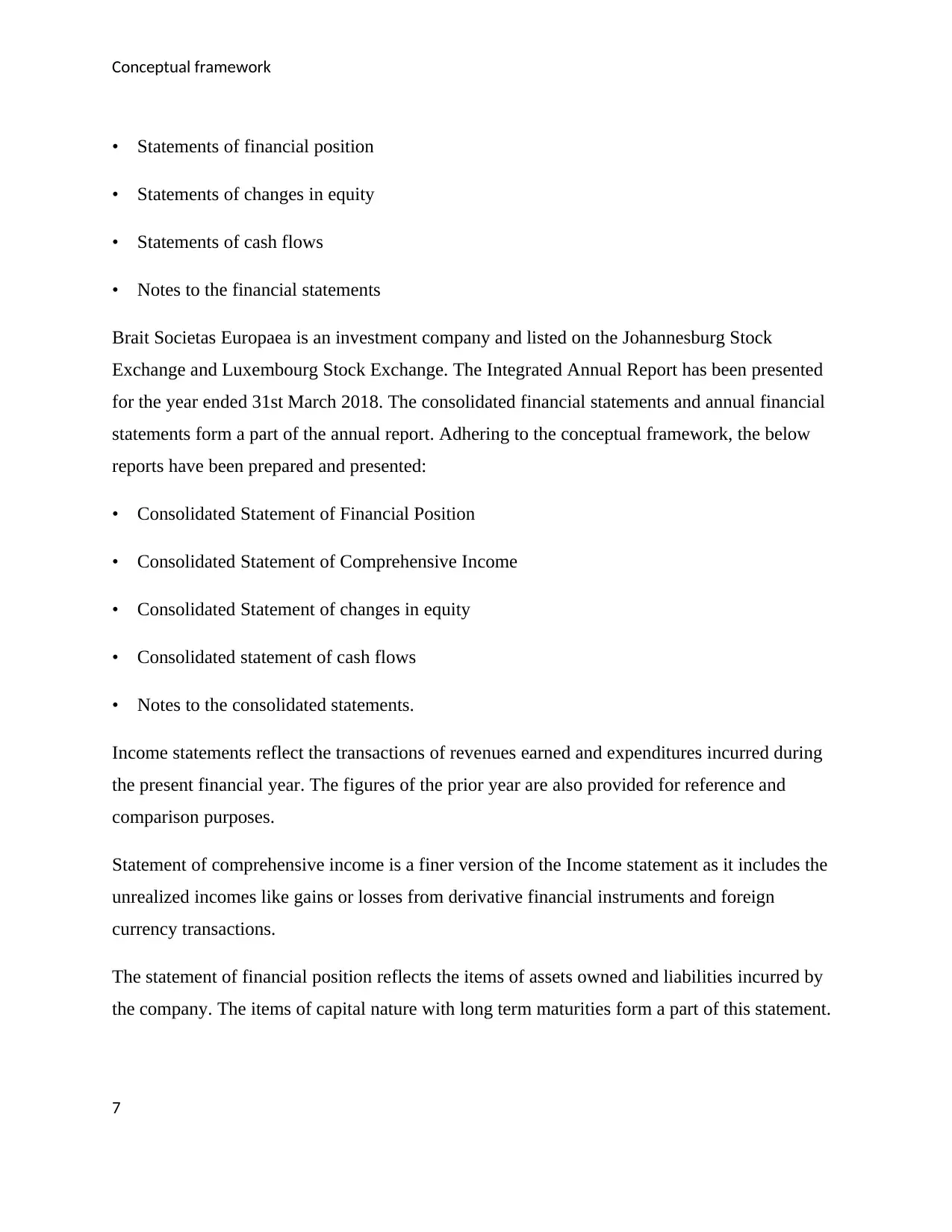
Conceptual framework
• Statements of financial position
• Statements of changes in equity
• Statements of cash flows
• Notes to the financial statements
Brait Societas Europaea is an investment company and listed on the Johannesburg Stock
Exchange and Luxembourg Stock Exchange. The Integrated Annual Report has been presented
for the year ended 31st March 2018. The consolidated financial statements and annual financial
statements form a part of the annual report. Adhering to the conceptual framework, the below
reports have been prepared and presented:
• Consolidated Statement of Financial Position
• Consolidated Statement of Comprehensive Income
• Consolidated Statement of changes in equity
• Consolidated statement of cash flows
• Notes to the consolidated statements.
Income statements reflect the transactions of revenues earned and expenditures incurred during
the present financial year. The figures of the prior year are also provided for reference and
comparison purposes.
Statement of comprehensive income is a finer version of the Income statement as it includes the
unrealized incomes like gains or losses from derivative financial instruments and foreign
currency transactions.
The statement of financial position reflects the items of assets owned and liabilities incurred by
the company. The items of capital nature with long term maturities form a part of this statement.
7
• Statements of financial position
• Statements of changes in equity
• Statements of cash flows
• Notes to the financial statements
Brait Societas Europaea is an investment company and listed on the Johannesburg Stock
Exchange and Luxembourg Stock Exchange. The Integrated Annual Report has been presented
for the year ended 31st March 2018. The consolidated financial statements and annual financial
statements form a part of the annual report. Adhering to the conceptual framework, the below
reports have been prepared and presented:
• Consolidated Statement of Financial Position
• Consolidated Statement of Comprehensive Income
• Consolidated Statement of changes in equity
• Consolidated statement of cash flows
• Notes to the consolidated statements.
Income statements reflect the transactions of revenues earned and expenditures incurred during
the present financial year. The figures of the prior year are also provided for reference and
comparison purposes.
Statement of comprehensive income is a finer version of the Income statement as it includes the
unrealized incomes like gains or losses from derivative financial instruments and foreign
currency transactions.
The statement of financial position reflects the items of assets owned and liabilities incurred by
the company. The items of capital nature with long term maturities form a part of this statement.
7
Paraphrase This Document
Need a fresh take? Get an instant paraphrase of this document with our AI Paraphraser
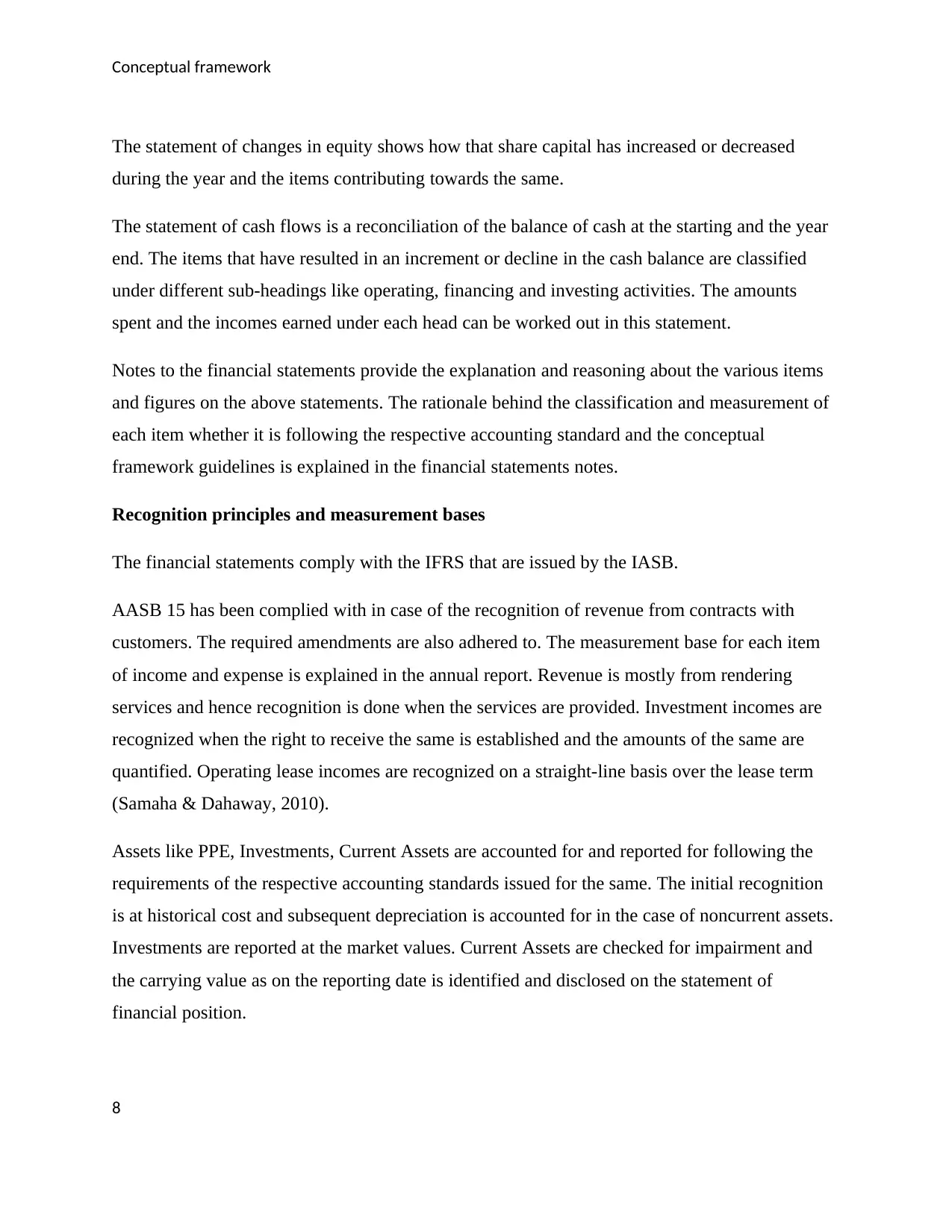
Conceptual framework
The statement of changes in equity shows how that share capital has increased or decreased
during the year and the items contributing towards the same.
The statement of cash flows is a reconciliation of the balance of cash at the starting and the year
end. The items that have resulted in an increment or decline in the cash balance are classified
under different sub-headings like operating, financing and investing activities. The amounts
spent and the incomes earned under each head can be worked out in this statement.
Notes to the financial statements provide the explanation and reasoning about the various items
and figures on the above statements. The rationale behind the classification and measurement of
each item whether it is following the respective accounting standard and the conceptual
framework guidelines is explained in the financial statements notes.
Recognition principles and measurement bases
The financial statements comply with the IFRS that are issued by the IASB.
AASB 15 has been complied with in case of the recognition of revenue from contracts with
customers. The required amendments are also adhered to. The measurement base for each item
of income and expense is explained in the annual report. Revenue is mostly from rendering
services and hence recognition is done when the services are provided. Investment incomes are
recognized when the right to receive the same is established and the amounts of the same are
quantified. Operating lease incomes are recognized on a straight-line basis over the lease term
(Samaha & Dahaway, 2010).
Assets like PPE, Investments, Current Assets are accounted for and reported for following the
requirements of the respective accounting standards issued for the same. The initial recognition
is at historical cost and subsequent depreciation is accounted for in the case of noncurrent assets.
Investments are reported at the market values. Current Assets are checked for impairment and
the carrying value as on the reporting date is identified and disclosed on the statement of
financial position.
8
The statement of changes in equity shows how that share capital has increased or decreased
during the year and the items contributing towards the same.
The statement of cash flows is a reconciliation of the balance of cash at the starting and the year
end. The items that have resulted in an increment or decline in the cash balance are classified
under different sub-headings like operating, financing and investing activities. The amounts
spent and the incomes earned under each head can be worked out in this statement.
Notes to the financial statements provide the explanation and reasoning about the various items
and figures on the above statements. The rationale behind the classification and measurement of
each item whether it is following the respective accounting standard and the conceptual
framework guidelines is explained in the financial statements notes.
Recognition principles and measurement bases
The financial statements comply with the IFRS that are issued by the IASB.
AASB 15 has been complied with in case of the recognition of revenue from contracts with
customers. The required amendments are also adhered to. The measurement base for each item
of income and expense is explained in the annual report. Revenue is mostly from rendering
services and hence recognition is done when the services are provided. Investment incomes are
recognized when the right to receive the same is established and the amounts of the same are
quantified. Operating lease incomes are recognized on a straight-line basis over the lease term
(Samaha & Dahaway, 2010).
Assets like PPE, Investments, Current Assets are accounted for and reported for following the
requirements of the respective accounting standards issued for the same. The initial recognition
is at historical cost and subsequent depreciation is accounted for in the case of noncurrent assets.
Investments are reported at the market values. Current Assets are checked for impairment and
the carrying value as on the reporting date is identified and disclosed on the statement of
financial position.
8
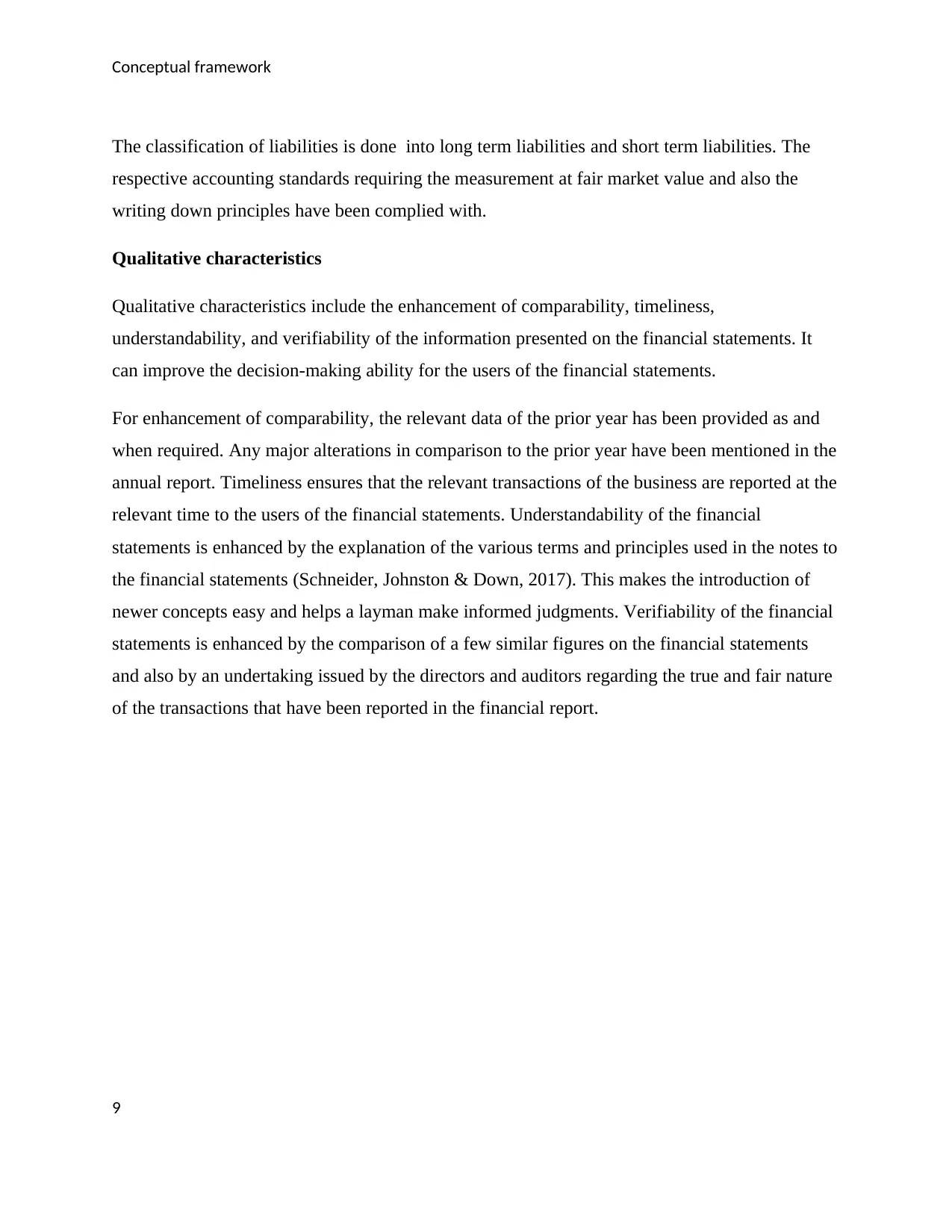
Conceptual framework
The classification of liabilities is done into long term liabilities and short term liabilities. The
respective accounting standards requiring the measurement at fair market value and also the
writing down principles have been complied with.
Qualitative characteristics
Qualitative characteristics include the enhancement of comparability, timeliness,
understandability, and verifiability of the information presented on the financial statements. It
can improve the decision-making ability for the users of the financial statements.
For enhancement of comparability, the relevant data of the prior year has been provided as and
when required. Any major alterations in comparison to the prior year have been mentioned in the
annual report. Timeliness ensures that the relevant transactions of the business are reported at the
relevant time to the users of the financial statements. Understandability of the financial
statements is enhanced by the explanation of the various terms and principles used in the notes to
the financial statements (Schneider, Johnston & Down, 2017). This makes the introduction of
newer concepts easy and helps a layman make informed judgments. Verifiability of the financial
statements is enhanced by the comparison of a few similar figures on the financial statements
and also by an undertaking issued by the directors and auditors regarding the true and fair nature
of the transactions that have been reported in the financial report.
9
The classification of liabilities is done into long term liabilities and short term liabilities. The
respective accounting standards requiring the measurement at fair market value and also the
writing down principles have been complied with.
Qualitative characteristics
Qualitative characteristics include the enhancement of comparability, timeliness,
understandability, and verifiability of the information presented on the financial statements. It
can improve the decision-making ability for the users of the financial statements.
For enhancement of comparability, the relevant data of the prior year has been provided as and
when required. Any major alterations in comparison to the prior year have been mentioned in the
annual report. Timeliness ensures that the relevant transactions of the business are reported at the
relevant time to the users of the financial statements. Understandability of the financial
statements is enhanced by the explanation of the various terms and principles used in the notes to
the financial statements (Schneider, Johnston & Down, 2017). This makes the introduction of
newer concepts easy and helps a layman make informed judgments. Verifiability of the financial
statements is enhanced by the comparison of a few similar figures on the financial statements
and also by an undertaking issued by the directors and auditors regarding the true and fair nature
of the transactions that have been reported in the financial report.
9
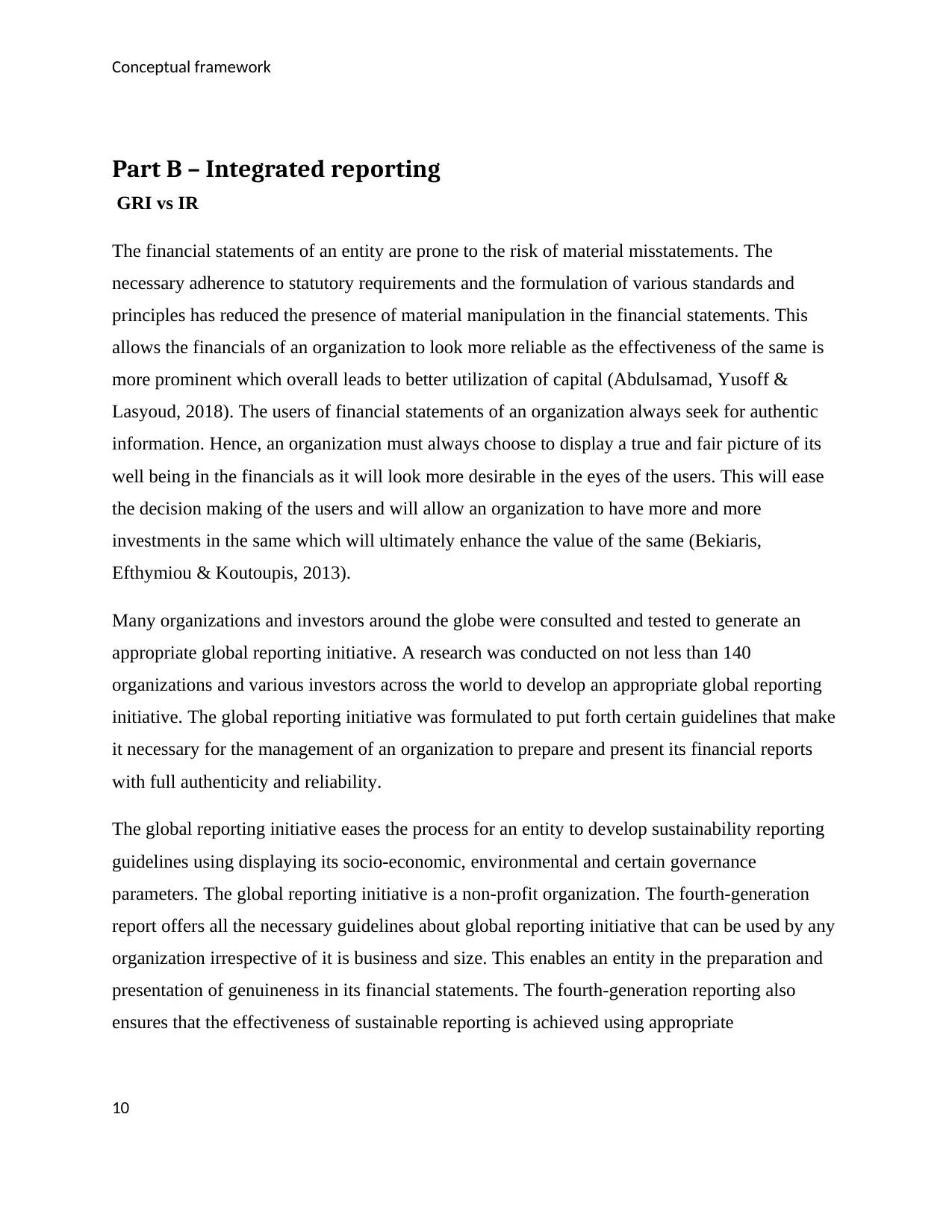
Conceptual framework
Part B – Integrated reporting
GRI vs IR
The financial statements of an entity are prone to the risk of material misstatements. The
necessary adherence to statutory requirements and the formulation of various standards and
principles has reduced the presence of material manipulation in the financial statements. This
allows the financials of an organization to look more reliable as the effectiveness of the same is
more prominent which overall leads to better utilization of capital (Abdulsamad, Yusoff &
Lasyoud, 2018). The users of financial statements of an organization always seek for authentic
information. Hence, an organization must always choose to display a true and fair picture of its
well being in the financials as it will look more desirable in the eyes of the users. This will ease
the decision making of the users and will allow an organization to have more and more
investments in the same which will ultimately enhance the value of the same (Bekiaris,
Efthymiou & Koutoupis, 2013).
Many organizations and investors around the globe were consulted and tested to generate an
appropriate global reporting initiative. A research was conducted on not less than 140
organizations and various investors across the world to develop an appropriate global reporting
initiative. The global reporting initiative was formulated to put forth certain guidelines that make
it necessary for the management of an organization to prepare and present its financial reports
with full authenticity and reliability.
The global reporting initiative eases the process for an entity to develop sustainability reporting
guidelines using displaying its socio-economic, environmental and certain governance
parameters. The global reporting initiative is a non-profit organization. The fourth-generation
report offers all the necessary guidelines about global reporting initiative that can be used by any
organization irrespective of it is business and size. This enables an entity in the preparation and
presentation of genuineness in its financial statements. The fourth-generation reporting also
ensures that the effectiveness of sustainable reporting is achieved using appropriate
10
Part B – Integrated reporting
GRI vs IR
The financial statements of an entity are prone to the risk of material misstatements. The
necessary adherence to statutory requirements and the formulation of various standards and
principles has reduced the presence of material manipulation in the financial statements. This
allows the financials of an organization to look more reliable as the effectiveness of the same is
more prominent which overall leads to better utilization of capital (Abdulsamad, Yusoff &
Lasyoud, 2018). The users of financial statements of an organization always seek for authentic
information. Hence, an organization must always choose to display a true and fair picture of its
well being in the financials as it will look more desirable in the eyes of the users. This will ease
the decision making of the users and will allow an organization to have more and more
investments in the same which will ultimately enhance the value of the same (Bekiaris,
Efthymiou & Koutoupis, 2013).
Many organizations and investors around the globe were consulted and tested to generate an
appropriate global reporting initiative. A research was conducted on not less than 140
organizations and various investors across the world to develop an appropriate global reporting
initiative. The global reporting initiative was formulated to put forth certain guidelines that make
it necessary for the management of an organization to prepare and present its financial reports
with full authenticity and reliability.
The global reporting initiative eases the process for an entity to develop sustainability reporting
guidelines using displaying its socio-economic, environmental and certain governance
parameters. The global reporting initiative is a non-profit organization. The fourth-generation
report offers all the necessary guidelines about global reporting initiative that can be used by any
organization irrespective of it is business and size. This enables an entity in the preparation and
presentation of genuineness in its financial statements. The fourth-generation reporting also
ensures that the effectiveness of sustainable reporting is achieved using appropriate
10
Secure Best Marks with AI Grader
Need help grading? Try our AI Grader for instant feedback on your assignments.
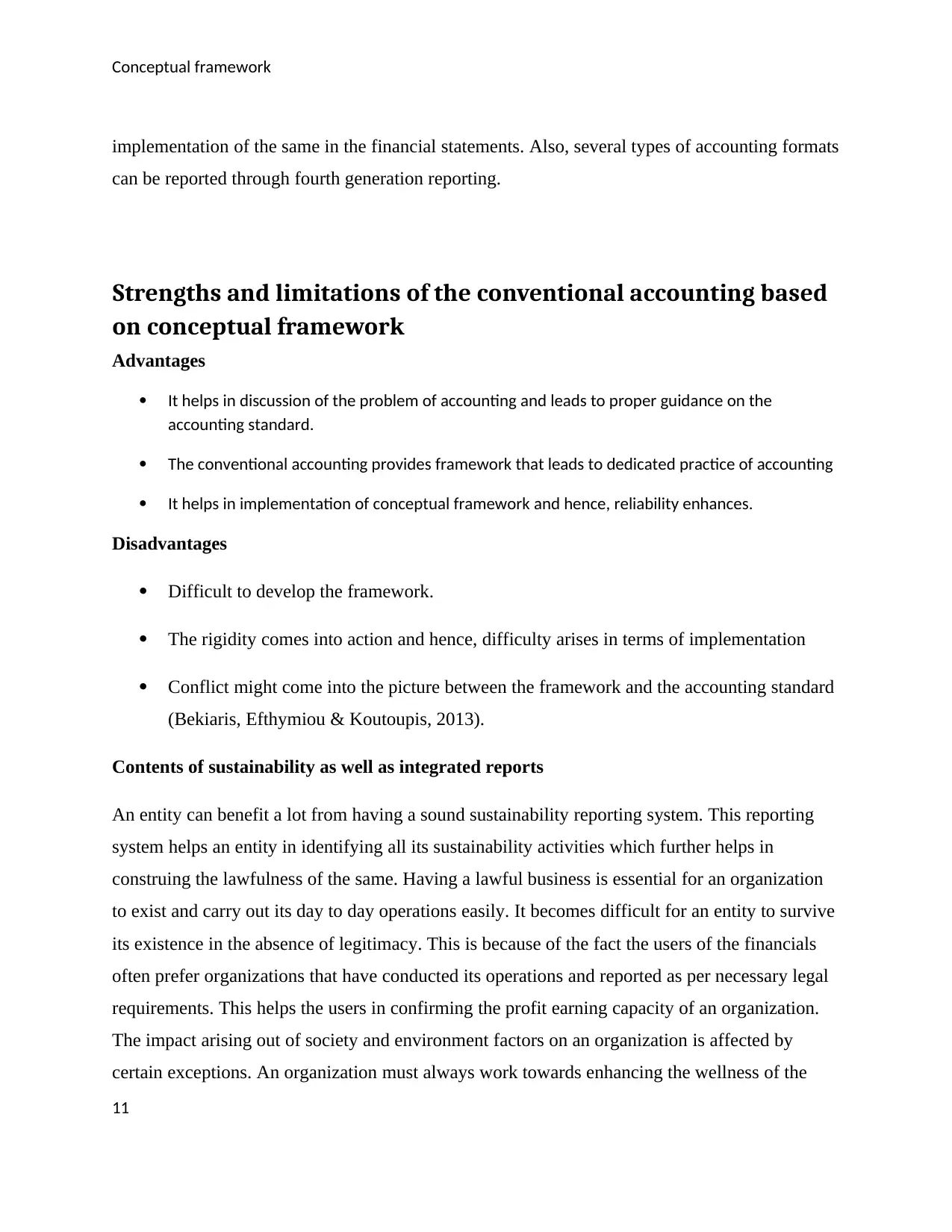
Conceptual framework
implementation of the same in the financial statements. Also, several types of accounting formats
can be reported through fourth generation reporting.
Strengths and limitations of the conventional accounting based
on conceptual framework
Advantages
It helps in discussion of the problem of accounting and leads to proper guidance on the
accounting standard.
The conventional accounting provides framework that leads to dedicated practice of accounting
It helps in implementation of conceptual framework and hence, reliability enhances.
Disadvantages
Difficult to develop the framework.
The rigidity comes into action and hence, difficulty arises in terms of implementation
Conflict might come into the picture between the framework and the accounting standard
(Bekiaris, Efthymiou & Koutoupis, 2013).
Contents of sustainability as well as integrated reports
An entity can benefit a lot from having a sound sustainability reporting system. This reporting
system helps an entity in identifying all its sustainability activities which further helps in
construing the lawfulness of the same. Having a lawful business is essential for an organization
to exist and carry out its day to day operations easily. It becomes difficult for an entity to survive
its existence in the absence of legitimacy. This is because of the fact the users of the financials
often prefer organizations that have conducted its operations and reported as per necessary legal
requirements. This helps the users in confirming the profit earning capacity of an organization.
The impact arising out of society and environment factors on an organization is affected by
certain exceptions. An organization must always work towards enhancing the wellness of the
11
implementation of the same in the financial statements. Also, several types of accounting formats
can be reported through fourth generation reporting.
Strengths and limitations of the conventional accounting based
on conceptual framework
Advantages
It helps in discussion of the problem of accounting and leads to proper guidance on the
accounting standard.
The conventional accounting provides framework that leads to dedicated practice of accounting
It helps in implementation of conceptual framework and hence, reliability enhances.
Disadvantages
Difficult to develop the framework.
The rigidity comes into action and hence, difficulty arises in terms of implementation
Conflict might come into the picture between the framework and the accounting standard
(Bekiaris, Efthymiou & Koutoupis, 2013).
Contents of sustainability as well as integrated reports
An entity can benefit a lot from having a sound sustainability reporting system. This reporting
system helps an entity in identifying all its sustainability activities which further helps in
construing the lawfulness of the same. Having a lawful business is essential for an organization
to exist and carry out its day to day operations easily. It becomes difficult for an entity to survive
its existence in the absence of legitimacy. This is because of the fact the users of the financials
often prefer organizations that have conducted its operations and reported as per necessary legal
requirements. This helps the users in confirming the profit earning capacity of an organization.
The impact arising out of society and environment factors on an organization is affected by
certain exceptions. An organization must always work towards enhancing the wellness of the
11
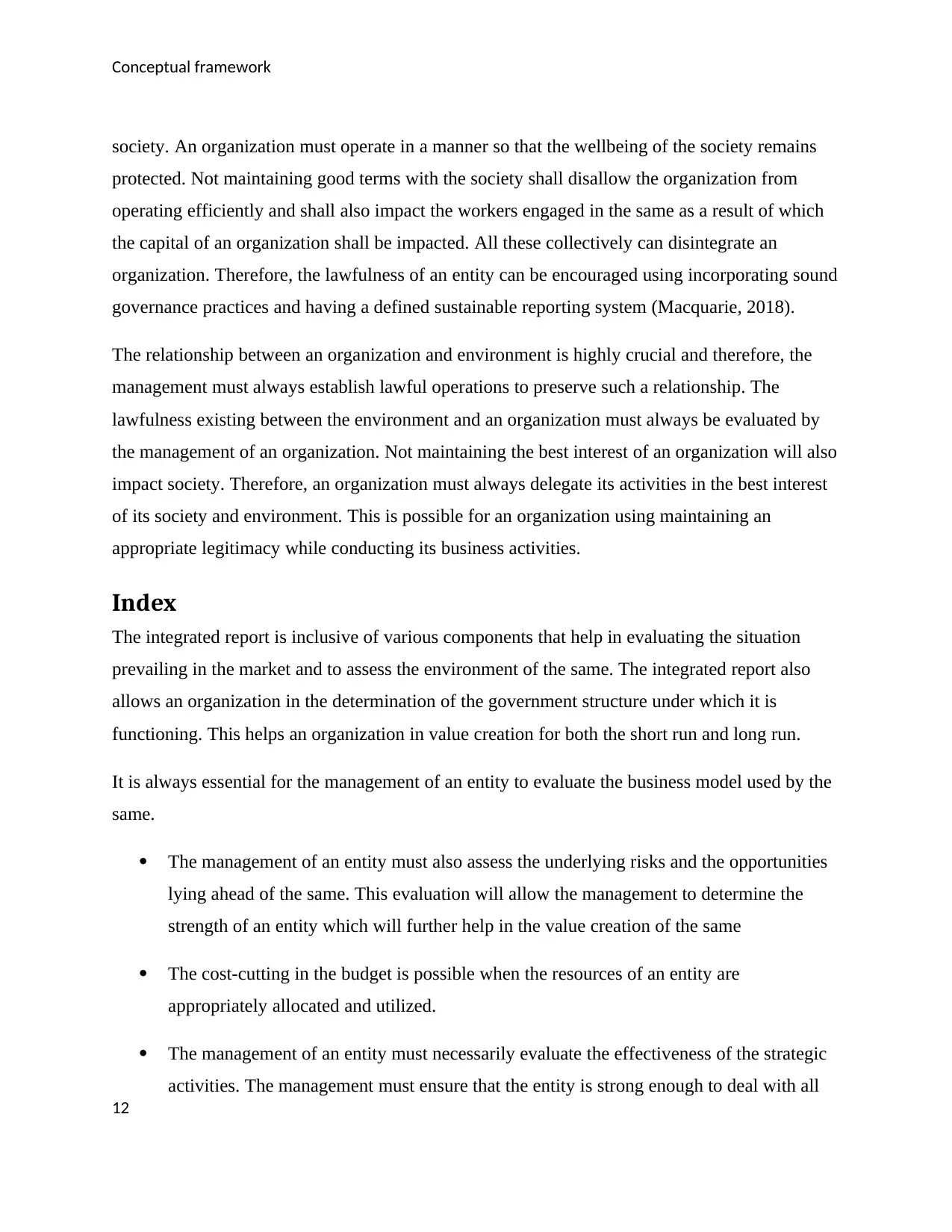
Conceptual framework
society. An organization must operate in a manner so that the wellbeing of the society remains
protected. Not maintaining good terms with the society shall disallow the organization from
operating efficiently and shall also impact the workers engaged in the same as a result of which
the capital of an organization shall be impacted. All these collectively can disintegrate an
organization. Therefore, the lawfulness of an entity can be encouraged using incorporating sound
governance practices and having a defined sustainable reporting system (Macquarie, 2018).
The relationship between an organization and environment is highly crucial and therefore, the
management must always establish lawful operations to preserve such a relationship. The
lawfulness existing between the environment and an organization must always be evaluated by
the management of an organization. Not maintaining the best interest of an organization will also
impact society. Therefore, an organization must always delegate its activities in the best interest
of its society and environment. This is possible for an organization using maintaining an
appropriate legitimacy while conducting its business activities.
Index
The integrated report is inclusive of various components that help in evaluating the situation
prevailing in the market and to assess the environment of the same. The integrated report also
allows an organization in the determination of the government structure under which it is
functioning. This helps an organization in value creation for both the short run and long run.
It is always essential for the management of an entity to evaluate the business model used by the
same.
The management of an entity must also assess the underlying risks and the opportunities
lying ahead of the same. This evaluation will allow the management to determine the
strength of an entity which will further help in the value creation of the same
The cost-cutting in the budget is possible when the resources of an entity are
appropriately allocated and utilized.
The management of an entity must necessarily evaluate the effectiveness of the strategic
activities. The management must ensure that the entity is strong enough to deal with all
12
society. An organization must operate in a manner so that the wellbeing of the society remains
protected. Not maintaining good terms with the society shall disallow the organization from
operating efficiently and shall also impact the workers engaged in the same as a result of which
the capital of an organization shall be impacted. All these collectively can disintegrate an
organization. Therefore, the lawfulness of an entity can be encouraged using incorporating sound
governance practices and having a defined sustainable reporting system (Macquarie, 2018).
The relationship between an organization and environment is highly crucial and therefore, the
management must always establish lawful operations to preserve such a relationship. The
lawfulness existing between the environment and an organization must always be evaluated by
the management of an organization. Not maintaining the best interest of an organization will also
impact society. Therefore, an organization must always delegate its activities in the best interest
of its society and environment. This is possible for an organization using maintaining an
appropriate legitimacy while conducting its business activities.
Index
The integrated report is inclusive of various components that help in evaluating the situation
prevailing in the market and to assess the environment of the same. The integrated report also
allows an organization in the determination of the government structure under which it is
functioning. This helps an organization in value creation for both the short run and long run.
It is always essential for the management of an entity to evaluate the business model used by the
same.
The management of an entity must also assess the underlying risks and the opportunities
lying ahead of the same. This evaluation will allow the management to determine the
strength of an entity which will further help in the value creation of the same
The cost-cutting in the budget is possible when the resources of an entity are
appropriately allocated and utilized.
The management of an entity must necessarily evaluate the effectiveness of the strategic
activities. The management must ensure that the entity is strong enough to deal with all
12
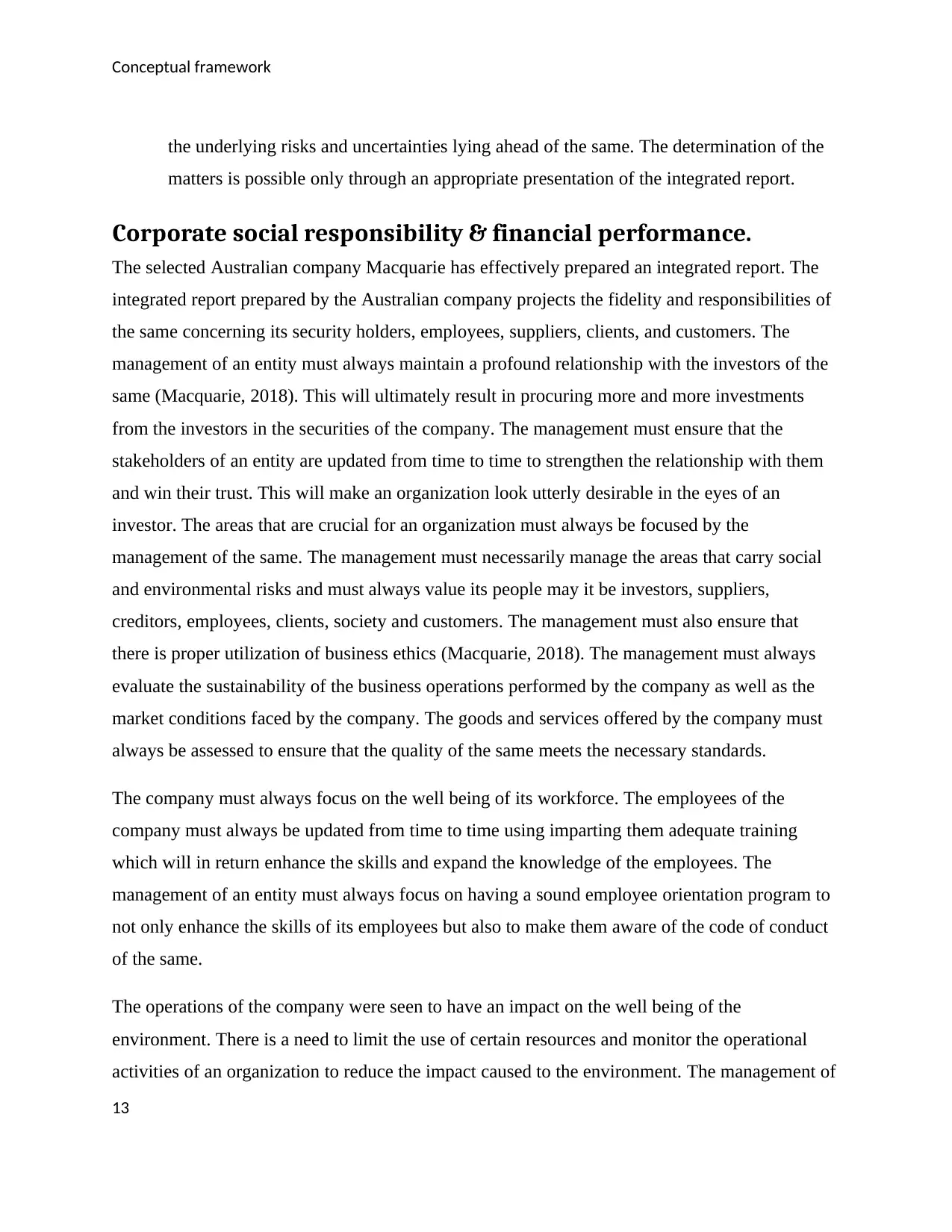
Conceptual framework
the underlying risks and uncertainties lying ahead of the same. The determination of the
matters is possible only through an appropriate presentation of the integrated report.
Corporate social responsibility & financial performance.
The selected Australian company Macquarie has effectively prepared an integrated report. The
integrated report prepared by the Australian company projects the fidelity and responsibilities of
the same concerning its security holders, employees, suppliers, clients, and customers. The
management of an entity must always maintain a profound relationship with the investors of the
same (Macquarie, 2018). This will ultimately result in procuring more and more investments
from the investors in the securities of the company. The management must ensure that the
stakeholders of an entity are updated from time to time to strengthen the relationship with them
and win their trust. This will make an organization look utterly desirable in the eyes of an
investor. The areas that are crucial for an organization must always be focused by the
management of the same. The management must necessarily manage the areas that carry social
and environmental risks and must always value its people may it be investors, suppliers,
creditors, employees, clients, society and customers. The management must also ensure that
there is proper utilization of business ethics (Macquarie, 2018). The management must always
evaluate the sustainability of the business operations performed by the company as well as the
market conditions faced by the company. The goods and services offered by the company must
always be assessed to ensure that the quality of the same meets the necessary standards.
The company must always focus on the well being of its workforce. The employees of the
company must always be updated from time to time using imparting them adequate training
which will in return enhance the skills and expand the knowledge of the employees. The
management of an entity must always focus on having a sound employee orientation program to
not only enhance the skills of its employees but also to make them aware of the code of conduct
of the same.
The operations of the company were seen to have an impact on the well being of the
environment. There is a need to limit the use of certain resources and monitor the operational
activities of an organization to reduce the impact caused to the environment. The management of
13
the underlying risks and uncertainties lying ahead of the same. The determination of the
matters is possible only through an appropriate presentation of the integrated report.
Corporate social responsibility & financial performance.
The selected Australian company Macquarie has effectively prepared an integrated report. The
integrated report prepared by the Australian company projects the fidelity and responsibilities of
the same concerning its security holders, employees, suppliers, clients, and customers. The
management of an entity must always maintain a profound relationship with the investors of the
same (Macquarie, 2018). This will ultimately result in procuring more and more investments
from the investors in the securities of the company. The management must ensure that the
stakeholders of an entity are updated from time to time to strengthen the relationship with them
and win their trust. This will make an organization look utterly desirable in the eyes of an
investor. The areas that are crucial for an organization must always be focused by the
management of the same. The management must necessarily manage the areas that carry social
and environmental risks and must always value its people may it be investors, suppliers,
creditors, employees, clients, society and customers. The management must also ensure that
there is proper utilization of business ethics (Macquarie, 2018). The management must always
evaluate the sustainability of the business operations performed by the company as well as the
market conditions faced by the company. The goods and services offered by the company must
always be assessed to ensure that the quality of the same meets the necessary standards.
The company must always focus on the well being of its workforce. The employees of the
company must always be updated from time to time using imparting them adequate training
which will in return enhance the skills and expand the knowledge of the employees. The
management of an entity must always focus on having a sound employee orientation program to
not only enhance the skills of its employees but also to make them aware of the code of conduct
of the same.
The operations of the company were seen to have an impact on the well being of the
environment. There is a need to limit the use of certain resources and monitor the operational
activities of an organization to reduce the impact caused to the environment. The management of
13
Paraphrase This Document
Need a fresh take? Get an instant paraphrase of this document with our AI Paraphraser
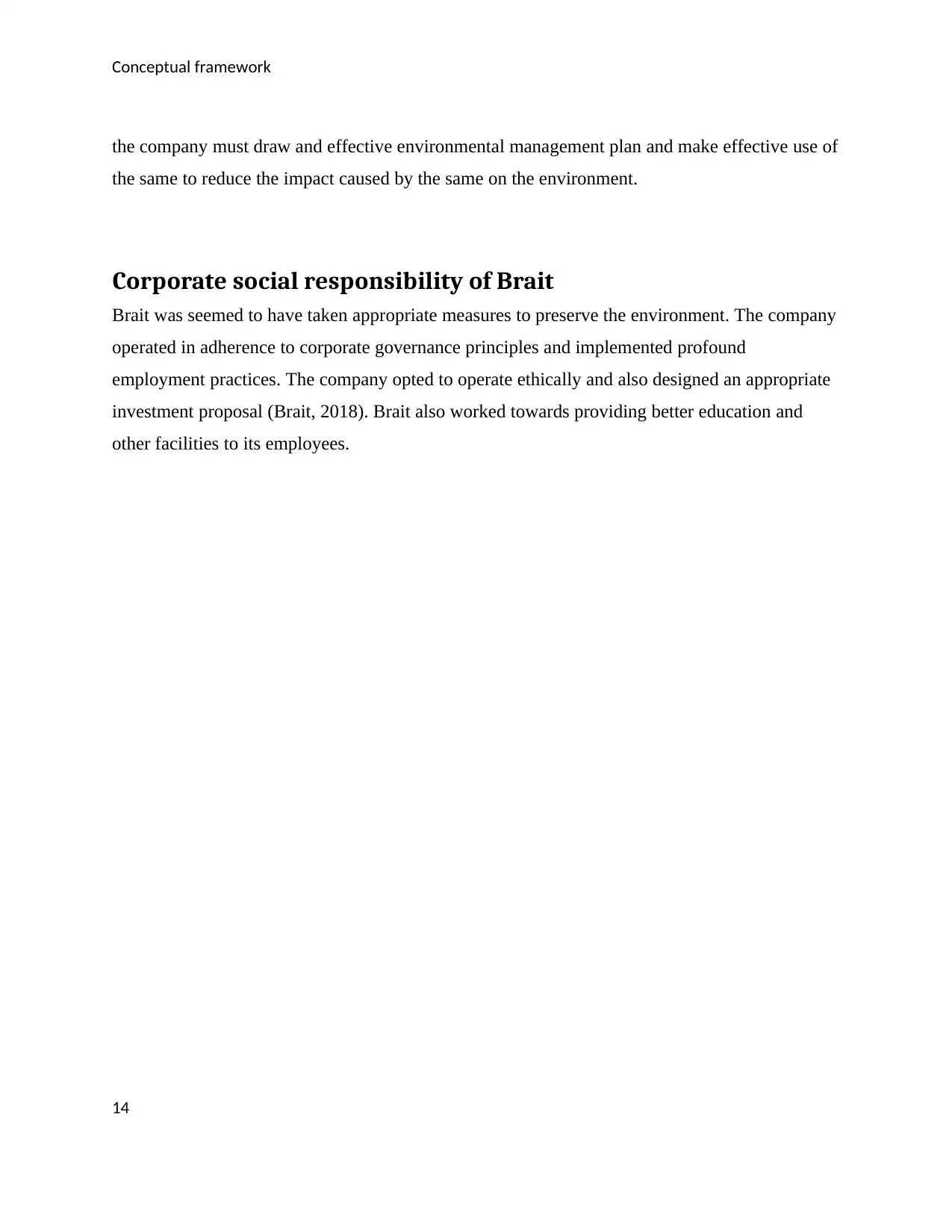
Conceptual framework
the company must draw and effective environmental management plan and make effective use of
the same to reduce the impact caused by the same on the environment.
Corporate social responsibility of Brait
Brait was seemed to have taken appropriate measures to preserve the environment. The company
operated in adherence to corporate governance principles and implemented profound
employment practices. The company opted to operate ethically and also designed an appropriate
investment proposal (Brait, 2018). Brait also worked towards providing better education and
other facilities to its employees.
14
the company must draw and effective environmental management plan and make effective use of
the same to reduce the impact caused by the same on the environment.
Corporate social responsibility of Brait
Brait was seemed to have taken appropriate measures to preserve the environment. The company
operated in adherence to corporate governance principles and implemented profound
employment practices. The company opted to operate ethically and also designed an appropriate
investment proposal (Brait, 2018). Brait also worked towards providing better education and
other facilities to its employees.
14
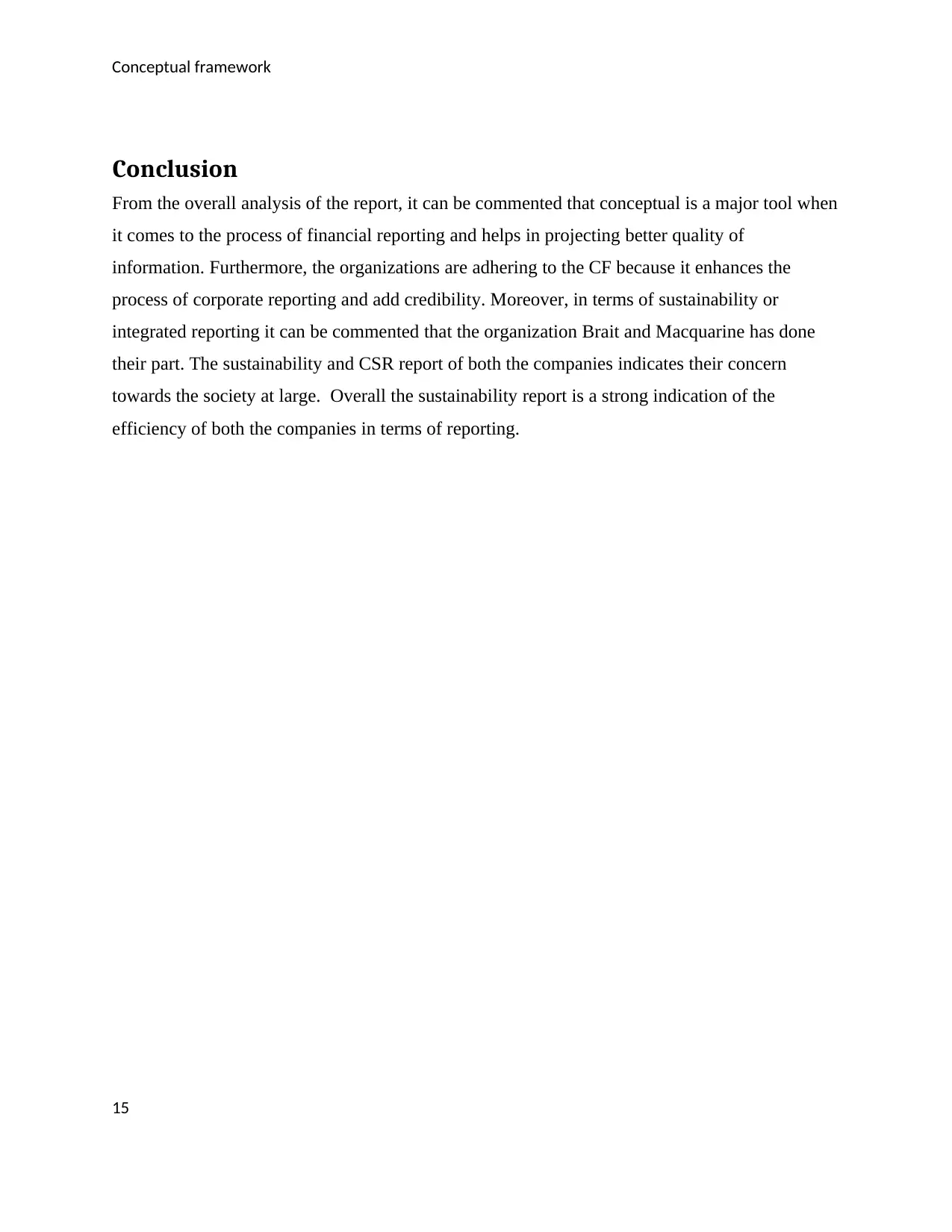
Conceptual framework
Conclusion
From the overall analysis of the report, it can be commented that conceptual is a major tool when
it comes to the process of financial reporting and helps in projecting better quality of
information. Furthermore, the organizations are adhering to the CF because it enhances the
process of corporate reporting and add credibility. Moreover, in terms of sustainability or
integrated reporting it can be commented that the organization Brait and Macquarine has done
their part. The sustainability and CSR report of both the companies indicates their concern
towards the society at large. Overall the sustainability report is a strong indication of the
efficiency of both the companies in terms of reporting.
15
Conclusion
From the overall analysis of the report, it can be commented that conceptual is a major tool when
it comes to the process of financial reporting and helps in projecting better quality of
information. Furthermore, the organizations are adhering to the CF because it enhances the
process of corporate reporting and add credibility. Moreover, in terms of sustainability or
integrated reporting it can be commented that the organization Brait and Macquarine has done
their part. The sustainability and CSR report of both the companies indicates their concern
towards the society at large. Overall the sustainability report is a strong indication of the
efficiency of both the companies in terms of reporting.
15
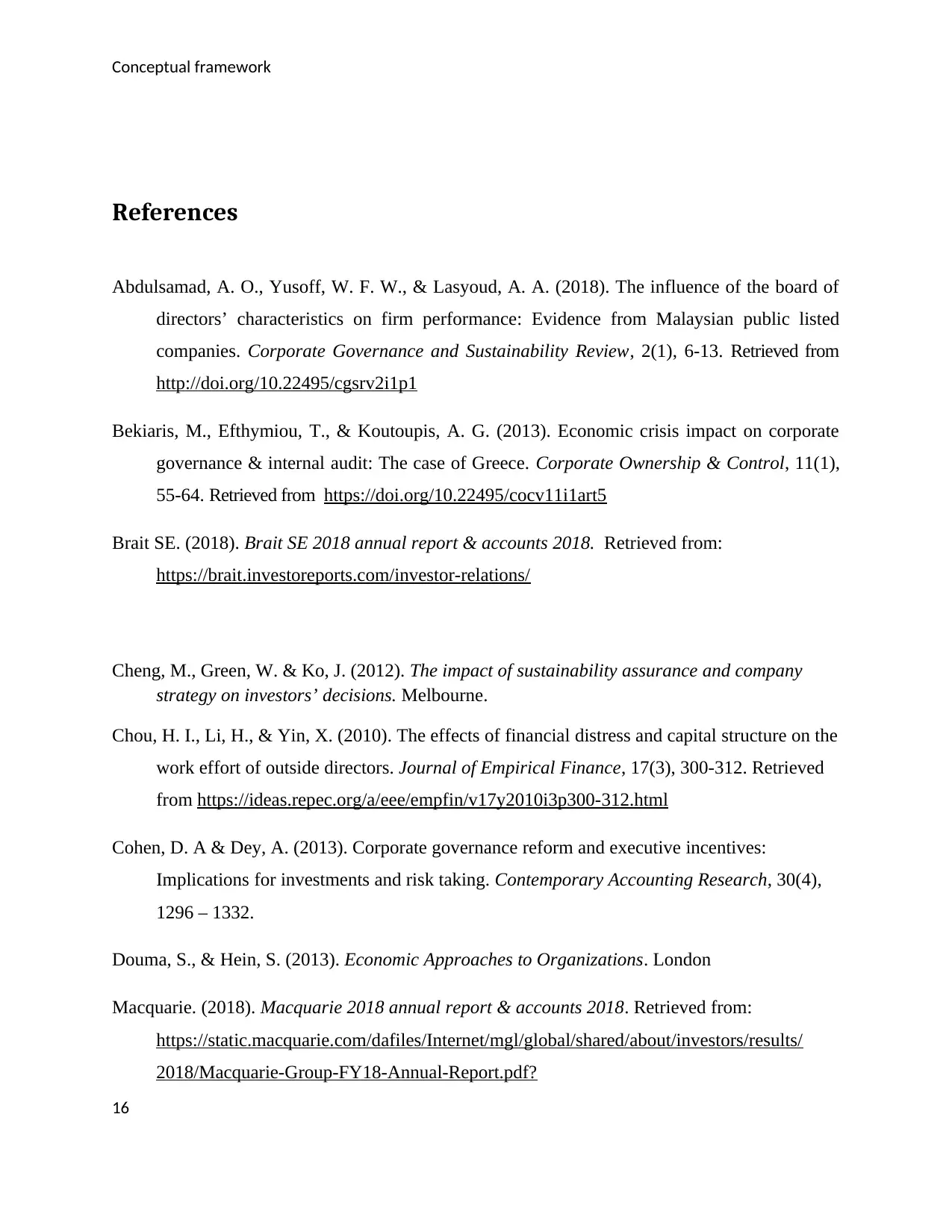
Conceptual framework
References
Abdulsamad, A. O., Yusoff, W. F. W., & Lasyoud, A. A. (2018). The influence of the board of
directors’ characteristics on firm performance: Evidence from Malaysian public listed
companies. Corporate Governance and Sustainability Review, 2(1), 6-13. Retrieved from
http://doi.org/10.22495/cgsrv2i1p1
Bekiaris, M., Efthymiou, T., & Koutoupis, A. G. (2013). Economic crisis impact on corporate
governance & internal audit: The case of Greece. Corporate Ownership & Control, 11(1),
55-64. Retrieved from https://doi.org/10.22495/cocv11i1art5
Brait SE. (2018). Brait SE 2018 annual report & accounts 2018. Retrieved from:
https://brait.investoreports.com/investor-relations/
Cheng, M., Green, W. & Ko, J. (2012). The impact of sustainability assurance and company
strategy on investors’ decisions. Melbourne.
Chou, H. I., Li, H., & Yin, X. (2010). The effects of financial distress and capital structure on the
work effort of outside directors. Journal of Empirical Finance, 17(3), 300-312. Retrieved
from https://ideas.repec.org/a/eee/empfin/v17y2010i3p300-312.html
Cohen, D. A & Dey, A. (2013). Corporate governance reform and executive incentives:
Implications for investments and risk taking. Contemporary Accounting Research, 30(4),
1296 – 1332.
Douma, S., & Hein, S. (2013). Economic Approaches to Organizations. London
Macquarie. (2018). Macquarie 2018 annual report & accounts 2018. Retrieved from:
https://static.macquarie.com/dafiles/Internet/mgl/global/shared/about/investors/results/
2018/Macquarie-Group-FY18-Annual-Report.pdf?
16
References
Abdulsamad, A. O., Yusoff, W. F. W., & Lasyoud, A. A. (2018). The influence of the board of
directors’ characteristics on firm performance: Evidence from Malaysian public listed
companies. Corporate Governance and Sustainability Review, 2(1), 6-13. Retrieved from
http://doi.org/10.22495/cgsrv2i1p1
Bekiaris, M., Efthymiou, T., & Koutoupis, A. G. (2013). Economic crisis impact on corporate
governance & internal audit: The case of Greece. Corporate Ownership & Control, 11(1),
55-64. Retrieved from https://doi.org/10.22495/cocv11i1art5
Brait SE. (2018). Brait SE 2018 annual report & accounts 2018. Retrieved from:
https://brait.investoreports.com/investor-relations/
Cheng, M., Green, W. & Ko, J. (2012). The impact of sustainability assurance and company
strategy on investors’ decisions. Melbourne.
Chou, H. I., Li, H., & Yin, X. (2010). The effects of financial distress and capital structure on the
work effort of outside directors. Journal of Empirical Finance, 17(3), 300-312. Retrieved
from https://ideas.repec.org/a/eee/empfin/v17y2010i3p300-312.html
Cohen, D. A & Dey, A. (2013). Corporate governance reform and executive incentives:
Implications for investments and risk taking. Contemporary Accounting Research, 30(4),
1296 – 1332.
Douma, S., & Hein, S. (2013). Economic Approaches to Organizations. London
Macquarie. (2018). Macquarie 2018 annual report & accounts 2018. Retrieved from:
https://static.macquarie.com/dafiles/Internet/mgl/global/shared/about/investors/results/
2018/Macquarie-Group-FY18-Annual-Report.pdf?
16
Secure Best Marks with AI Grader
Need help grading? Try our AI Grader for instant feedback on your assignments.
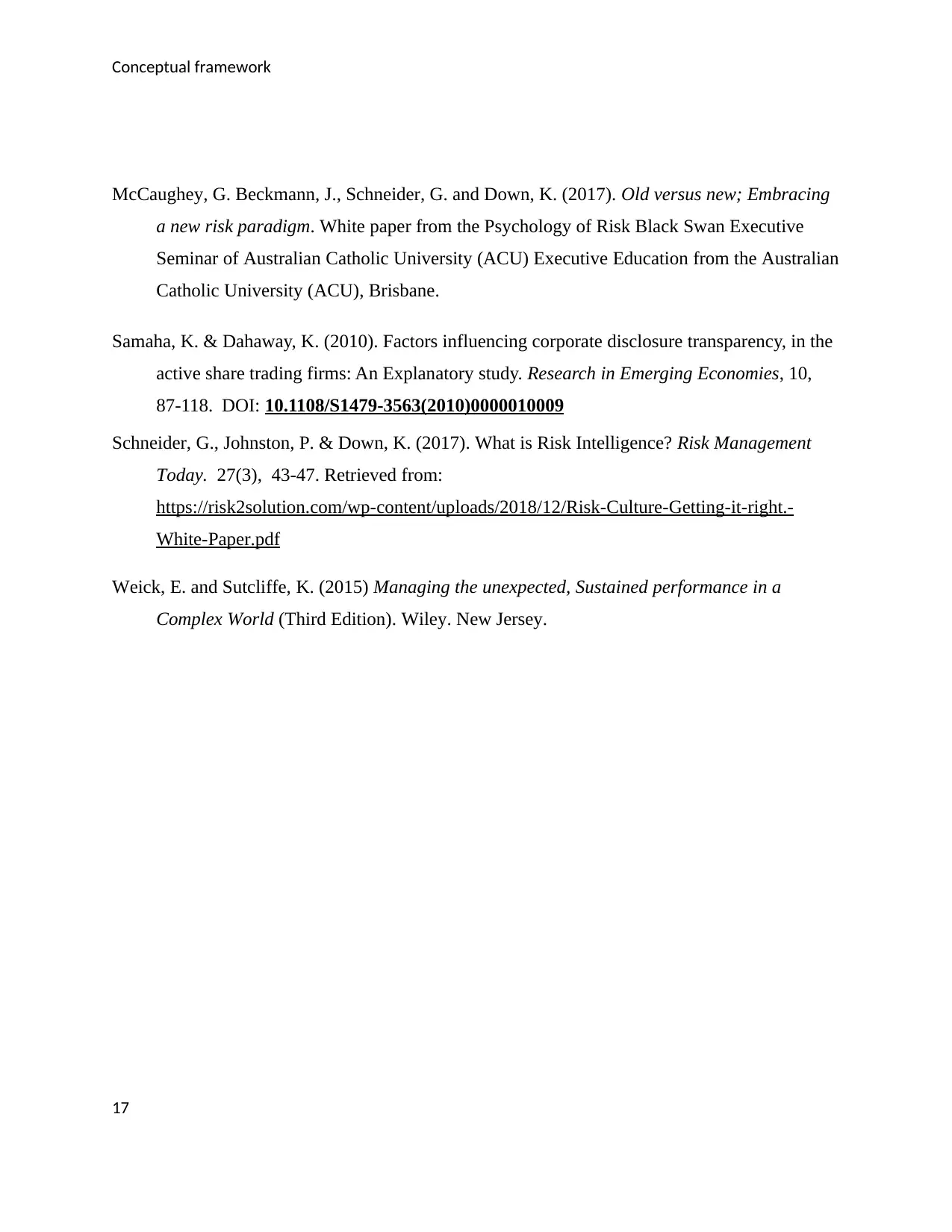
Conceptual framework
McCaughey, G. Beckmann, J., Schneider, G. and Down, K. (2017). Old versus new; Embracing
a new risk paradigm. White paper from the Psychology of Risk Black Swan Executive
Seminar of Australian Catholic University (ACU) Executive Education from the Australian
Catholic University (ACU), Brisbane.
Samaha, K. & Dahaway, K. (2010). Factors influencing corporate disclosure transparency, in the
active share trading firms: An Explanatory study. Research in Emerging Economies, 10,
87-118. DOI: 10.1108/S1479-3563(2010)0000010009
Schneider, G., Johnston, P. & Down, K. (2017). What is Risk Intelligence? Risk Management
Today. 27(3), 43-47. Retrieved from:
https://risk2solution.com/wp-content/uploads/2018/12/Risk-Culture-Getting-it-right.-
White-Paper.pdf
Weick, E. and Sutcliffe, K. (2015) Managing the unexpected, Sustained performance in a
Complex World (Third Edition). Wiley. New Jersey.
17
McCaughey, G. Beckmann, J., Schneider, G. and Down, K. (2017). Old versus new; Embracing
a new risk paradigm. White paper from the Psychology of Risk Black Swan Executive
Seminar of Australian Catholic University (ACU) Executive Education from the Australian
Catholic University (ACU), Brisbane.
Samaha, K. & Dahaway, K. (2010). Factors influencing corporate disclosure transparency, in the
active share trading firms: An Explanatory study. Research in Emerging Economies, 10,
87-118. DOI: 10.1108/S1479-3563(2010)0000010009
Schneider, G., Johnston, P. & Down, K. (2017). What is Risk Intelligence? Risk Management
Today. 27(3), 43-47. Retrieved from:
https://risk2solution.com/wp-content/uploads/2018/12/Risk-Culture-Getting-it-right.-
White-Paper.pdf
Weick, E. and Sutcliffe, K. (2015) Managing the unexpected, Sustained performance in a
Complex World (Third Edition). Wiley. New Jersey.
17
1 out of 17
Related Documents
Your All-in-One AI-Powered Toolkit for Academic Success.
+13062052269
info@desklib.com
Available 24*7 on WhatsApp / Email
![[object Object]](/_next/static/media/star-bottom.7253800d.svg)
Unlock your academic potential
© 2024 | Zucol Services PVT LTD | All rights reserved.





